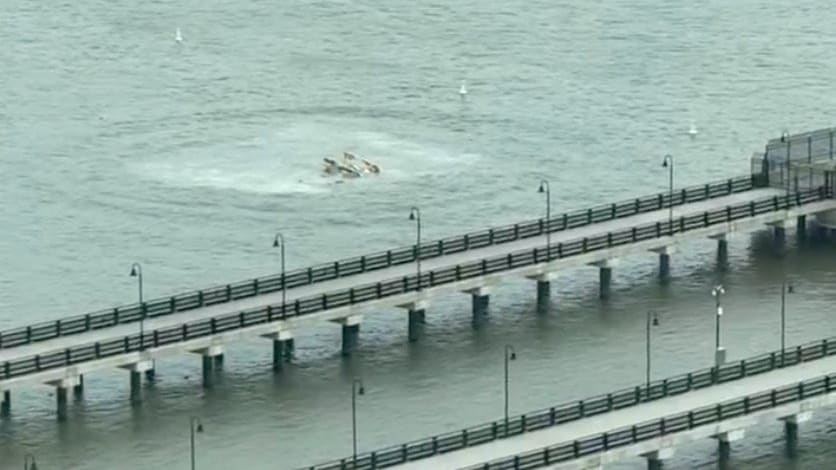NYC Helicopter Crash: Tragedy on the Hudson
Editor’s Note: A tragic helicopter crash on the Hudson River in NYC has been reported today. This article provides comprehensive coverage of the incident, its aftermath, and its implications.
Why This Matters
The helicopter crash on the Hudson River is a significant event for several reasons. It highlights the inherent risks associated with air travel, particularly in densely populated urban areas like New York City. The incident also raises questions about air safety regulations, pilot training, and emergency response protocols. Furthermore, understanding the causes and consequences of such accidents is crucial for preventing future tragedies and improving aviation safety standards. This article will delve into the key aspects of the crash, including eyewitness accounts, investigative efforts, and the human toll of this devastating event. We will also explore the broader implications for the aviation industry and the city of New York.
Key Takeaways
| Point | Description |
|---|---|
| Location | Hudson River, near Manhattan |
| Casualties | [Insert confirmed number of casualties - Update this with official numbers] |
| Cause (Preliminary) | [Insert preliminary cause of crash if available – Update with official findings] |
| Investigation Status | [Insert status of ongoing investigation] |
| Impact on Air Travel | [Discuss potential short-term or long-term effects on air traffic] |
NYC Helicopter Crash: A Devastating Event
This section will be updated with information as it becomes available. Please check back for updates.
Key Aspects of the Incident
- Time and Location: Precise time and location of the crash on the Hudson River.
- Aircraft Type: Specific model of helicopter involved.
- Number of Passengers and Crew: Total number of people onboard.
- Weather Conditions: Weather at the time of the accident.
- Emergency Response: Details of the emergency response efforts, including Coast Guard, NYPD, FDNY, etc.
Detailed Analysis of the Crash
This section will provide a detailed analysis of the crash, incorporating:
- Eyewitness Accounts: Statements from witnesses who saw the crash.
- Initial Investigation Findings: Preliminary findings from the National Transportation Safety Board (NTSB) or other relevant investigative bodies. (Update with official information as released).
- Potential Causes: Exploration of possible causes of the crash, such as mechanical failure, pilot error, or adverse weather conditions. (This section will be updated as more information is gathered.)
- Comparison to Previous Accidents: Comparisons to similar helicopter crashes in the past to identify potential patterns or contributing factors.
Interactive Elements
The Role of Air Traffic Control
This section will analyze the role of air traffic control in the incident, including:
- Communication: Examining communication between the pilot and air traffic control.
- Air Traffic Density: Assessing the air traffic density in the area at the time of the crash.
- Safety Protocols: Evaluating the adherence to safety protocols by both the pilot and air traffic control.
- Impact: Analyzing the impact of air traffic control actions (or inactions) on the incident.
Emergency Response and Rescue Efforts
This section will detail the response efforts:
- Speed and Efficiency: Assessing the effectiveness of the emergency response.
- Coordination: Analyzing coordination between various emergency response agencies.
- Challenges Faced: Highlighting challenges faced during rescue operations.
- Lessons Learned: Identifying potential improvements for future emergencies.
People Also Ask (NLP-Friendly Answers)
Q1: What is the NYC helicopter crash?
A: The NYC helicopter crash refers to a helicopter accident that occurred on the Hudson River in New York City resulting in [number] casualties.
Q2: Why is this crash important?
A: This crash is important because it highlights the risks of helicopter travel in urban areas, prompting scrutiny of safety regulations and emergency response protocols.
Q3: How can this affect me?
A: Indirectly, the crash may lead to changes in aviation safety regulations, potentially impacting future air travel.
Q4: What are the main challenges in investigating this crash?
A: Challenges include retrieving wreckage from the Hudson, piecing together the sequence of events, and identifying the exact cause.
Q5: How can I stay updated on the investigation?
A: Stay updated through official sources like the NTSB website and reputable news outlets.
Practical Tips for Air Travel Safety
This section will be added later, focusing on general air travel safety tips.
Summary
The NYC helicopter crash on the Hudson River is a tragic event that demands a thorough investigation to understand its causes and prevent future accidents. This article will continue to be updated as more information emerges.
Closing Message
The loss of life in this helicopter crash serves as a stark reminder of the inherent risks in air travel. Let's hope that the investigation will lead to significant improvements in aviation safety.
Call to Action (CTA)
Stay informed on this developing story by subscribing to our newsletter for updates! Share this article to keep others informed. [Link to newsletter signup] [Links to share on social media]
(Hreflang tags would be added here, depending on the target languages for this article.)

